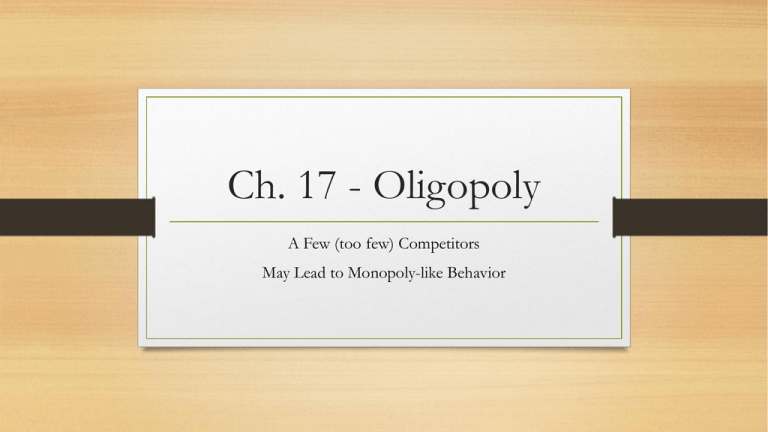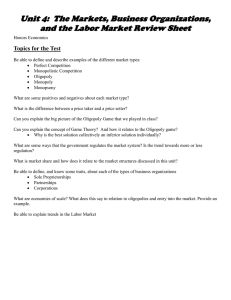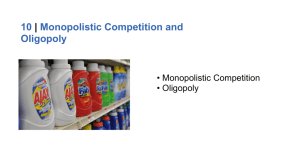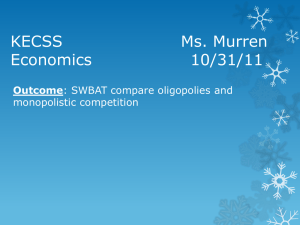Ch. 17 - Oligopoly A Few (too few) Competitors
advertisement

Ch. 17 - Oligopoly A Few (too few) Competitors May Lead to Monopoly-like Behavior What is an Oligopoly? • market in which the industry is dominated by a small number of sellers • Derived from the Greek for few sellers. • Since there are few participants, each oligopolist (firm) is aware of the actions of the others • decisions of one firm influence, and are influenced by the decisions of other firms • i.e., firms’ behave strategically taking into account the likely responses of the other market participants (game theory) 2 Oligopoly • Oligopoly markets are more concentrated than monopolistically competitive markets, but less concentrated than monopolies. Perfect Competition Monopolistic Competition Monopoly Oligopoly 3 Oligopolies - Characteristics • Businesses that are part of an oligopoly share some common characteristics: • They are less concentrated than in a monopoly, but more concentrated than in a competitive system. • There is still competition within an oligopoly, as in the case of airlines. Airlines match competitor’s air fares when sharing the same routes. Also, automobile companies compete in the fall as the new models come out. One will reduce financing rates and the others will follow suit. • The businesses offer an identical product or services. • This creates a high amount of interdependence which encourages competition in non price- related areas, like advertising and packaging. The tobacco companies, soft drink companies, and airlines are examples of an imperfect oligopoly. Oligopolistic Industries - Examples Industries which are examples of oligopolies include: • Steel industry • Aluminum • Film • Television • Cell phone • Gas Examples of Oligopoly • Four music companies control 80% of the market - Universal Music Group, Sony • • • • Music Entertainment, Warner Music Group and EMI Group Six major book publishers - Random House, Pearson, Hachette, HarperCollins, Simon & Schuster and Holtzbrinck Four breakfast cereal manufacturers - Kellogg, General Mills, Post and Quaker Two major producers in the beer industry - Anheuser-Busch and MillerCoors Two major providers in the healthcare insurance market - Anthem and Kaiser Permanente Pros and Cons of Oligopolies • Pros • Pro: Prices in an oligopoly are usually lower than in a monopoly, but higher than it would be in a competitive market. • Pro: Prices tend to remain stable because if one company lowers the price too much, then the others will do the same. The result lowers the profit margin for all the companies, but is great for the consumer Pros and Cons of Oligopolies • Con: Output would be less than in a competitive market and more than in a monopoly. Most competition between companies in an oligopoly is by means of research and development (or innovation), location, packaging, marketing, and the production of a product that is slightly different than the other company makes. • Con: Major barriers keep companies from joining oligopolies. The major barriers are economies of scale, access to technology, patents, and actions of the businesses in the oligopoly. Barriers can also be imposed by the government, such as limiting the number of licenses that are issued. • Con: Oligopolies develop in industries that require a large sum of money to start. Existing companies in oligopolies discourage new companies because of exclusive access to resources or patented processes, cost advantages as the result of mass production, and the cost of convincing consumers to try a new product. • Lastly, companies in oligopolies establish exclusive dealerships, have agreements to get lower prices from suppliers, and lower prices with the intention of keeping new companies out. Are US Industries Becoming More Concentrated? • Abstract – AEA Nov 2015 • More than 90% of U.S. industries have experienced an increase in concentration levels over the last two decades. Firms in industries with the largest increase in product market concentration have enjoyed higher profit margins, positive abnormal stock returns, and more profitable M&A deals, suggesting that market power is becoming an important source of value. This phenomenon has been mainly driven by the consolidation of publicly-traded firms into larger entities. The increased level of concentration due to public firms' consolidation has not been offset by a larger presence of private or foreign firms. Overall, our findings suggest that the nature of U.S. product markets has undergone a structural shift that has weakened competition. How do we tell? • Market concentration refers to the size and distribution of firm market shares and the number of firms in the market. • Economists use two measures of industry concentration: • Four-firm Concentration Ratio • The Herfindahl-Hirschman Index 10 Four-Firm Concentration Ratio • The four-firm concentration ratio (CR4) measures market concentration by adding the market shares of the four largest firms in an industry. • If CR4 > 60, then the market is likely to be oligopolistic. 11 The Herfindahl-Hirschman Index • The Herfindahl-Hirschman index (HHI) is found by summing the squares of the market shares of all firms in an industry. • Advantages over the CR4 measure: • Captures changes in market shares • Uses data on all firms • HHI > 1800 - > Potentially Too Concentrated 12 Figure 12.11 Four-Firm Concentration Ratio (CR4) for Selected Industries in 1997 13 Non-competitive Oligopolies • Non-competitive/collusive behavior (cooperative oligopolies) • Cartels: firms may collude to raise prices and restrict production in the same way as a monopoly. Where there is a formal agreement for such collusion, this is known as a cartel. • Dominant Firm/Price Leader: • collude in an attempt to stabilize unstable markets, so as to reduce the risks inherent in these markets for investment and product development. • does not require formal agreement • although for the act to be illegal there must be a real communication between companies • for example, in some industries, there may be an acknowledged market leader which informally sets prices to which other producers respond, known as price leadership. • Stackleberg price-leader model 14 Duopoly Equilibrium in a Centralized Cartel 15 Cartel Pricing Tactic • Reduce Qs to monopoly levels in order to: • a) obtain a higher price • b) earn monopoly rents 16 Competition Versus Cartel (a) Firm (b) Market Price, p, $ per unit Price, p, $ per unit MC S pm pm AC pc pc MC m MCm em ec Market demand MR q m q c q* Quantity, q, Units per year Qm Qc Source: Jeffrey M. Perloff, Microeconomics, 3rd Ed., 2004, p. 435 Quantity, Q, Units per year 17 Strategic Behavior • Perfect Competition • Only strategy is to reduce costs • Price-taker => output decisions do not affect market price • cross-price elasticity = -1 (perfect substitutes) • Own-price = -∞ • Monopoly • Price-Searcher: output decision determines price • Cross-price = 0 (no substitutes) • Own-price: >= |1| • Oligopoly • • • • Cross-price elasticity near -1 Own-price elasticity > |1| Will have to take into account actions of other similar firms when making output/pricing decisions Much more strategy 18 Oligopoly Behavior • Cooperative Oligopoly • Cartels • Agree to collude; act/price like a single firm monoploist • Price leadership (Stackleberg leader) • Dominant firm establishes the price; other firms react to “leader” • Non-cooperative Oligopolies • Sticky prices (kinked demand curve) • Sticky upward • Nash equilibrium • Characterized by stable prices • Perfect competition • Completely rivalarous 19 Cooperative Oligopolies • Cartels (highly cooperative) • • Firms act as single-firm monopolist Stackelberg Price Leader (passive cooperation) - leader firm moves first and then the follower firms move sequentially • Stackelberg leader is sometimes referred to as the Market Leader. 20






